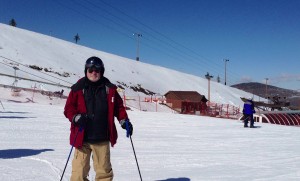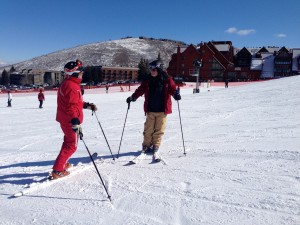When it comes to ski injuries – the best way to avoid them is to know the rule of 3’s. Ask any ER physician or orthopedic surgeon when to most ski injuries happen and they will tell you about:
RULE OF THREES
Most ski injuries happen when:
(1) After the third day of skiing. (2) After 3 p.m.
(3) Above 3,000 meters (about 9,000 feet).
THIRD DAY OF SKIING
Unless you have physically prepared for the sport, by keeping in shape year around, after the third day your body will be tired, and need a day off. After three days of skiing, plan on a day off. There are a lot of things to do in ski resorts besides skiing! Use that third or fourth day to explore the area, take a tour, shop, or just sit in the coffee shop with a good book.
When you don’t give your muscles a chance to rest, they tire easily and reaction time is decreased — all leading to more injuries.
Too often people have the attitude that with a short period of time they need to get as much skiing in as possible: consider three days at a time as much as possible. It is a lot easier to take a day off skiing and let the muscles recover than it is to spend a day in the hospital, with extended recovery after.
AFTER 3 PM
For most of us skiing is hard work. Yes, the gondola takes you up, and gravity takes you down -but it is hard work applying the brakes for skiing. The less familiar you are with skiing the harder you work at it. Take a break after two hours of skiing and get some water, or coffee, or tea (don’t worry, the coffee and tea will not dehydrate you but alcohol will). Take a nice lunch break and then think if you want to go back out again.
As soon as you notice your blades are getting crossed, or it is harder to make turns, it is time to go in.
ABOVE 3000 meters (9000 feet)
Altitude, anything above 6000 feet has changes that affect the body. Unless you live in Denver, or are in high altitude, it takes weeks to get use to this. You will breath harder, lose more fluid from your body, and your heart will work harder. This means your muscles will get sore and not react as fast, so you will get in trouble. (ok technically 3k is more like 9800 feet, but it just works better to say 3000 meters instead of 9000 feet).
ACUTE MOUNTAIN SICKNESS (AMS)
The higher you go, and the faster you get there, the more likely you will experience some symptoms of AMS. The first symptom is usually a headache, also called high altitude headache. . One survey done at a Colorado ski resort at 9800 ft found that 60% of visitors developed a headache. AMS includes other symptoms such as loss of appetite, nausea – sometimes with vomiting, weakness, dizziness, fatigue, and difficulty sleeping. AMS feels exactly like a bad hangover. Symptoms can occur from 2 to 24 hours. AMS does NOT develop after 2 days, unless you’ve moved to a higher altitude. If you have been doing well at altitude and then get sick after two or three days you probably have food poisoning, virus, or other medical problem.
The ability to adjust to higher altitude is genetic, as is the propensity to develop any altitude sickness. If your family members get sick at higher altitude then you have a chance of developing it. If you have family members who have had mountain illness, or have developed it in the past then spend the first night at an intermediate place. Denver is a mile high, and a good place to spend a night to help accomodate. Salt Lake City is a bit over 4,000 feet and Park City is at 6900 feet. While the lifts will take you to above 9,000 feet, and most ski in those upper areas, you want to have at least a day to accomodate. Consider spending the first day on the lower runs, get your legs about you or arrive a day early and visit the city.
ALCOHOL AND SKIING
You came to ski, not to drink. The more alcohol you drink, the more dehydrated you become – and in a few days of skiing you are not going to catch up. If your goal is to be on the slopes, have fun skiing, then avoid drinking. The more alcohol you drink the day/night before, the more likely you will get injured. The longer it will take your muscles to recover, and the more swollen you will become.
GET A LESSON
It never hurts to get your form back in style with a good ski lesson. If you ski four times a year or LESS having a professional watch your form, and help you navigate down some runs. They can find a set of runs appropriate for you, get you to work on a few simple items that will advance your skiing, and by improving your form you are less likely to have an injury.
It has been one year since I had been on the slopes so I got a private lesson from a Park City Ski Instructor. On our first run he noticed a few flaws in my technique that were easily corrected . Since he was familiar with the slopes, he took me to runs that were a lot less crowded, and enough of a challenge that I stayed interested. It was well worth the investment!







No Responses to “SNOW: Avoiding Ski Injuries – A Doctor’s Advice”